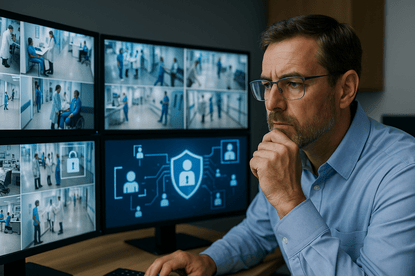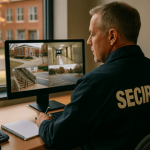
Artificial intelligence (AI) is rapidly transforming the world of hospital security. From detecting unusual movement to automating incident alerts, AI-powered surveillance systems are helping healthcare facilities monitor more efficiently and respond faster.
But while the technology is advancing, one question remains at the center of every conversation:
Can hospitals embrace AI surveillance without compromising patient privacy or HIPAA compliance?
The short answer is yes—but only if innovation is guided by accountability, transparency, and smart policy.
Let’s explore how AI-driven surveillance is reshaping hospital security and what leaders need to know to stay compliant.
k
k
The Promise of AI in Hospital Surveillance
Traditional security systems rely on human monitoring—watching hours of video footage to identify potential issues. AI changes that model completely.
With machine learning and advanced video analytics, modern hospital surveillance can now:
-
Detect unusual motion or behavior in restricted areas
-
Recognize unauthorized access attempts in real time
-
Alert staff automatically during emergencies or patient elopement events
-
Analyze patterns to improve security staffing or layout decisions
For healthcare environments that operate 24/7, these capabilities save time, reduce fatigue, and dramatically improve incident response.
Yet as powerful as AI is, it brings a new layer of responsibility. The same cameras that improve safety also capture sensitive environments where patient confidentiality is paramount.
k
k
Where HIPAA Comes In
The Health Insurance Portability and Accountability Act (HIPAA) doesn’t prohibit video surveillance—but it does regulate how identifiable patient information is handled.
If a security camera records a patient receiving treatment, that footage is considered protected health information (PHI). This means hospitals must treat it with the same level of security as medical records.
AI surveillance tools, especially those that store or analyze data in the cloud, must therefore:
-
Use encrypted storage and transmission methods
-
Restrict access to authorized personnel only
-
Keep detailed audit logs of who views or exports footage
-
Be covered under Business Associate Agreements (BAAs) with technology vendors
In other words, AI doesn’t exempt a facility from HIPAA—it must enhance compliance, not challenge it.
k
k
The Privacy Challenge of AI
AI surveillance systems can detect, track, and even classify movement—but this raises potential privacy concerns if not implemented carefully.
For example, facial recognition or behavior analysis tools could inadvertently identify patients or staff without consent. Hospitals must set strict boundaries on how these features are used, especially in areas like patient rooms, waiting areas, or treatment zones.
Best Practice:
Only deploy AI analytics where they serve a clear operational or safety purpose—such as entrances, pharmacies, data centers, or restricted corridors.
k
k
Building HIPAA-Compliant AI Surveillance
To implement AI surveillance responsibly, healthcare security leaders should follow a clear framework built around compliance, ethics, and transparency.
1. Use Privacy Masking Technology
Modern AI systems can automatically blur or block patient faces and sensitive areas in live and recorded footage. This allows real-time monitoring without exposing PHI unnecessarily.
2. Enforce Role-Based Access
Only authorized personnel should view or analyze AI-driven video feeds. Role-based permissions ensure staff only access what’s relevant to their responsibilities.
3. Audit Everything
Every interaction with AI surveillance data—viewing, exporting, or deleting—should generate an audit trail for accountability and compliance.
4. Choose Vendors Who Understand Healthcare
Partner with integrators and technology providers who specialize in HIPAA-compliant surveillance and can provide documentation for audits and BAAs.
5. Be Transparent with Staff and Patients
Post clear signage and communicate how AI surveillance is used for safety, not intrusion. Transparency builds trust and reduces concerns about over-monitoring.
k
k
The Benefits of Responsible AI Surveillance
When implemented correctly, AI surveillance helps healthcare facilities:
-
Reduce workplace violence through proactive threat detection
-
Prevent infant abductions or patient elopements with real-time alerts
-
Improve emergency response times with automated incident detection
-
Simplify compliance through automated logs and data retention controls
-
Protect staff and patients while maintaining privacy standards
AI doesn’t replace human judgment—it enhances it, allowing security teams to focus on action rather than endless monitoring.
k
k
Real-World Example: Smarter Surveillance in Action
A large medical center in the Southeast implemented AI-enabled surveillance across its main campus. The system detected patterns of loitering near restricted access doors—behavior human monitors had missed.
By integrating the AI alerts with their access control system, security staff could respond within seconds. At the same time, privacy masking software ensured that patient areas remained blurred in every recording, maintaining HIPAA compliance.
The result: improved situational awareness, faster response times, and complete auditability—without compromising privacy.
k
k
Conclusion
AI surveillance is transforming healthcare security for the better. It helps hospitals move from reactive protection to predictive prevention, identifying risks before they escalate.
But the key to success lies in how it’s used. HIPAA compliance, data security, and ethical deployment must always remain at the core.
By partnering with experienced integrators and choosing HIPAA-compliant systems, hospitals can confidently harness AI’s potential while keeping what matters most safe—their patients’ privacy and trust.
Talk to SSP about designing an AI-driven, HIPAA-compliant surveillance strategy that enhances security without sacrificing patient confidentiality.


